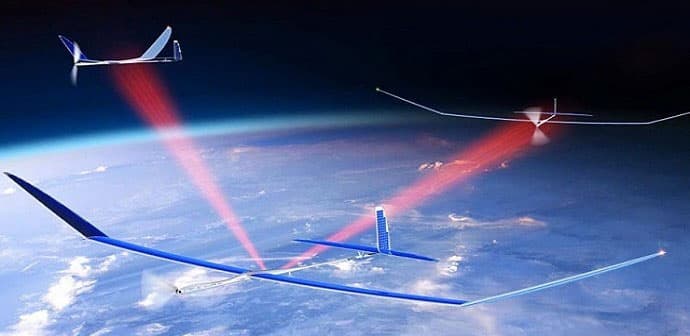Google SkyBender Drones Test 5G Internet Hotspots Using Millimeter Waves
Google has been testing a millimetre-wave radio transmission mechanism to improve wireless communication speeds. These high frequency millimetre waves can transmit data 40 times faster than 4G systems. The success of this mechanism lies entirely on the fact that it broadcasts over a different spectrum than today’s congested cellphone spectrum. Tests are in the initial phase, but this is not the first rime millimeter waves are taken advantage of. US military research organization, Darpa, had performed similar tests for mobile hotspots in 2014.

The drones used to test this new spectrum of high speed communication are solar-powered, and in addition to those, Google is also using an optionally-piloted aircraft called Centaur. These high-altitude drones are a result of Google Titan project, and have a wingspan of 50 meters.
However revolutionary the millimeter waves might be, they have their own limitations. For starters, they are very short range, and at the 28Ghz frequency it is being tested in, it covers only one tenth of the distance as a 4G transmission. And the technology to overcome this, focussed transmission from a phased array, is highly power-consuming and complex.
The tests are being conducted at New Mexico Spaceport Center, in association with Virgin Galactic. Google had to install a lot of its own hardware and a dedicated flight control center in and around the Spaceport Center. The drones are using Virgin Galactic’s 1500 square foot hangar for which Google is paying $1000 a day.
The drones are only one side of Google’s test story. They also have been trying out with balloons, codenamed Google Loon project, and have acquired permission from the Federal Communications Commissions (FCC) to carry out these tests at the Spaceport till July 2016.
Source: <a href="https://www.theguardian.com/technology/2016/jan/29/project-skybender-google-drone-tests-internet-spaceport-virgin-galactic" target="_blank" rel="nofollow noopener noreferrer">Project Skybender: Google's secretive 5G internet drone tests revealed | Google | The Guardian</a>

The drones used to test this new spectrum of high speed communication are solar-powered, and in addition to those, Google is also using an optionally-piloted aircraft called Centaur. These high-altitude drones are a result of Google Titan project, and have a wingspan of 50 meters.
However revolutionary the millimeter waves might be, they have their own limitations. For starters, they are very short range, and at the 28Ghz frequency it is being tested in, it covers only one tenth of the distance as a 4G transmission. And the technology to overcome this, focussed transmission from a phased array, is highly power-consuming and complex.
The tests are being conducted at New Mexico Spaceport Center, in association with Virgin Galactic. Google had to install a lot of its own hardware and a dedicated flight control center in and around the Spaceport Center. The drones are using Virgin Galactic’s 1500 square foot hangar for which Google is paying $1000 a day.
The drones are only one side of Google’s test story. They also have been trying out with balloons, codenamed Google Loon project, and have acquired permission from the Federal Communications Commissions (FCC) to carry out these tests at the Spaceport till July 2016.
Source: <a href="https://www.theguardian.com/technology/2016/jan/29/project-skybender-google-drone-tests-internet-spaceport-virgin-galactic" target="_blank" rel="nofollow noopener noreferrer">Project Skybender: Google's secretive 5G internet drone tests revealed | Google | The Guardian</a>
0
